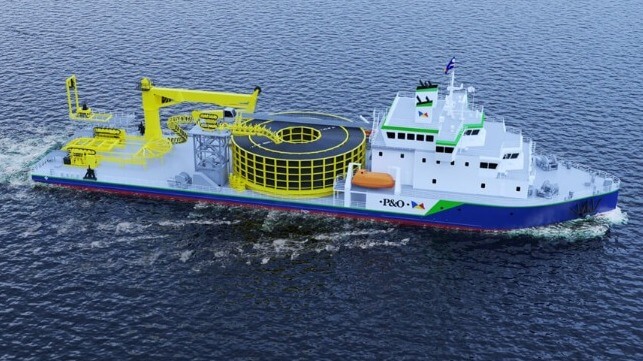P&O Maritime Logistics Plans Conversion for Methanol-Ready Cable Layer

With demand continuing to grow for vessels to support the coming build out in offshore wind farms, P&O Maritime Logistics announced plans for the conversion of one of the company’s existing multi-carry vessels into a cable-lying vessel designed to support wind farm construction. According to the company, the vessel will be the first of its kind within the fleet of specialized offshore vessels and will be designed to address the focus on sustainability.
Set to start operations in the third quarter of 2024, P&O Maritime says the vessel will incorporate unique capabilities to meet the requirements of the offshore wind industry. In addition to being a highly maneuverable vessel, it will feature a low-fuel consumption propulsion layout that will be ready for green methanol fuel and zero emission operations. The newly converted vessel will also be equipped with a state-of-the-art battery system.
“The conversion of our vessel is a real step change. It means, apart from expanding our existing services and products into a more specialized offering, that we can also make a positive contribution to the decarbonization of our industry,” said Martin Helweg, CEO of P&O Maritime Logistics. “By repurposing an existing vessel, we are able to extend the lifetime of this particular product quite significantly to keep up with the increasing demand in the sector.”
Supporting P&O Maritime Logistics’ global expansion plans and product offering, the new cable layer will have the ability to connect offshore structures and bring offshore energy onshore by installing export and inner array cables across vast distances. The company anticipates that one of the main uses of the vessel will be to connect offshore wind farms with the mainland. The cable laying vessel will predominately support the construction, development, and maintenance of existing and prospective wind farms.
Marc van der Zwaluw, Project Manager at C-Job Naval Architects, which will oversee the conversion project, highlights the value of repurposing an existing module carrier vessel. “With the increasing demand in the offshore wind sector, this vessel will be able to meet the operational demands for the installation of next-generation windmill infrastructure thanks to its optimized deck layout,” says van der Zwaluw. “The design focused on optimized vessel performance and features a DP-2 positioning system and a low fuel consumption propulsion layout that is ready for green methanol fuel and zero emission operations.”
The newly converted vessel will have the ability to host up to 64 seafarers and features a single basket cable carousel with an outside diameter of 24 meters. P&O highlights the span of operations it will be capable of providing with a core height of 5.5 meters, as well as a 30 tons SWL AHC subsea crane.
The conversion by P&O Maritime Logistics builds on the company’s recent multi-year project in Taiwan with the Topaz Installer. The company received a contract valued at $30 million in 2020 for three vessels operating in Taiwan’s emerging offshore wind market starting in 2021. The Topaz Installer, a cable-lay vessel, was assigned for shore-to-sea and inter-field cable arrays, while the Topaz Tangaroa, a light subsea construction vessel, was assigned to support the cable-lay vessel Nexus on cable trenching, and the Topaz Tiamat was assigned to support the installation of foundations and monopiles. The first phases of Taiwan’s Greater Changhua achieved first power in the spring of 2022 as the build out continued.
